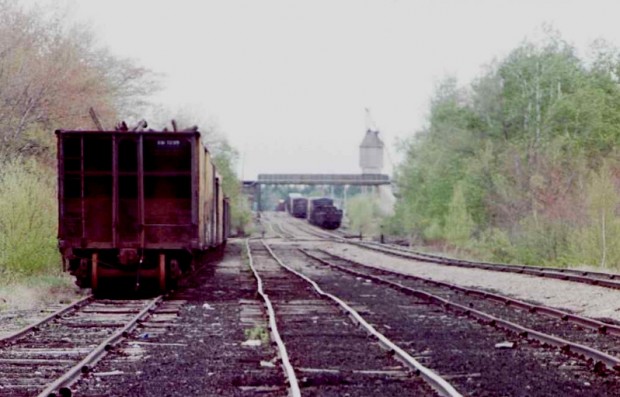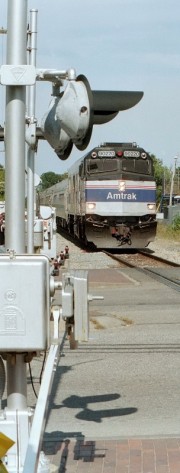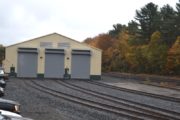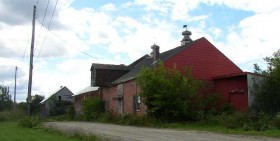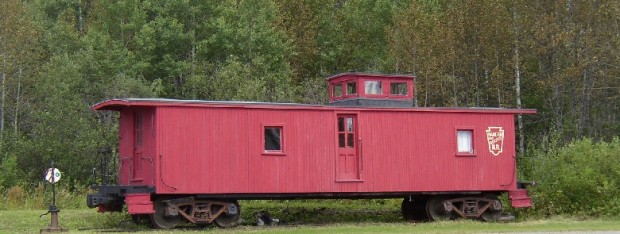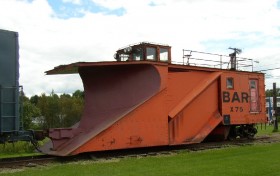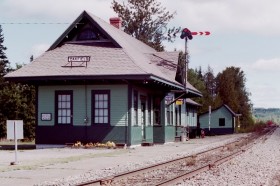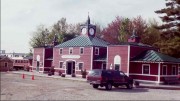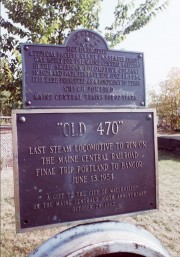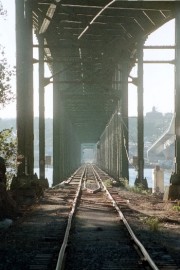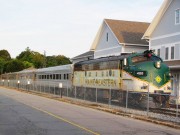A Brief History of Railroads Maine
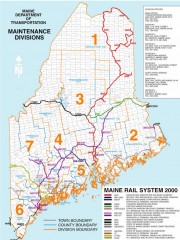 Railroad technology was first developed in Great Britain, and included Richard Trevithick’s steam locomotive of 1804 and George Stevenson’s locomotive “Rocket” of 1829.
Railroad technology was first developed in Great Britain, and included Richard Trevithick’s steam locomotive of 1804 and George Stevenson’s locomotive “Rocket” of 1829.
In addition to the standard gauge (width) lines reviewed here, narrow gauge railroads also had a special role to play in the state.
The first railroad companies in Maine were chartered in 1832 and 1833, and, after some initial difficulties, the first line of tracks was completed in 1836 by the Bangor & Piscataquis Canal & Railroad from Bangor to Old Town. This became the second railroad in New England after the Boston & Lowell Railroad, which began operations in 1835.
After a century of expansion, little was done to enlarge the rail network in Maine. The peak year of railroad mileage in the country was in 1920, and in Maine in 1924 with approximately 2,380 miles. From the 1920’s onward, the abandonment, and in most cases, the removal of track was the norm in Maine. A line was built to connect the South Portland Shipyard to rail early in World War II. Not until the 1970’s, 80’s, and 90’s was any significant work done on Maine’s railroads. Interestingly, American railroads today carry more freight than was moved in the first Golden Age of railroading.
The Northern Maine Junction in Hermon, just west of Bangor, links the north-south Bangor and Aroostook with the east-west Maine Central system.
Short line narrow gauge railroads were built to move wood from forests to mills. A few connected local communities, such as one connecting Wiscasset to Albion running along the Sheepscot River. Another in northern Franklin County ran from Farmington to Rangeley, and from Strong to Kingfield and Bigelow. Others connected Bridgton with the Maine Central Railroad, and Monson with the Bangor and Aroostook Railroad.
Early Railroad Stations
Some 19th century railroad station survive, many thanks to the National Register of Historic Places. [Search “railroad stations” (with quotes) for articles related to them.] Here are three examples: (click to enlarge any photos)
AMTRAK
Passenger service was restored in 2002 in southern Maine as AMTRAK operated the Downeaster over Guilford Rail System tracks, providing trains several times daily between Portland and Boston, with several stops along the way in Maine, New Hampshire, and Massachusetts.
Maine stations, from south to north, are as follows: Wells, Saco, Old Orchard Beach, Portland, Freeport, and Brunswick.
At Old Orchard Beach the service recalls the time when tourism thrived decades ago thanks to the train service from Boston and New York.
The Northern New England Passenger Rail Authority sets policy for the Downeaster. In 2012 the service was extended north of Portland to Freeport and Brunswick. Residents and businesses in Lewiston, Augusta and Rockland have expressed an interest in participating.
In 2016 a $13 million “Layover Facility” was completed in Brunswick (below), enabling improved AMTRAK service to Boston. It eliminated the need to runs train for hours awaiting the next trip and provided the opportunity for indoor maintenance. Track improvements in 2016 allowed an additional train to Boston.
Aroostook Valley Railroad
The construction of the Aroostook Valley Railroad began in 1909 with a line from Washburn to Presque Isle and was operational in June 1910. In following years, branch lines were constructed in New Sweden, Carson, and Caribou. The financing of the Aroostook Valley Railroad was done through the issuance of stocks and bonds which were paid off in 1952.
In its prime years, the Aroostook Valley Railroad owned thirty-two miles of mainline track. The photo at right is of the now defunct Colby Siding on the Colby Road in Woodland, west of Caribou.
Normal operations called for a train to make one round trip per day between Presque Isle and Caribou. It was eventually abandoned and closed up in early 1996.
Bangor and Aroostook Railroad
In 1864, a group of businessmen from Bangor obtained a charter from the State of Maine to construct a railroad from Bangor to Moosehead Lake. The first president of the line was Hannibal Hamlin. In 1868, the State of Maine granted 75,000 acres to the company for the construction of the railroad.
In 1891, the Bangor and Aroostook Railroad (BAR) was incorporated as it combined the Bangor and Piscataquis Railroad and the Bangor and Katahdin Railroad. In 1893, a BAR train operated to Houlton. Oakfield, just south west of Houlton, has maintained the station there as a museum.
The main line reached Caribou and the branch to Fort Fairfield was completed in 1894. By 1905, connections were made to Patten, Limestone, Ashland, and Van Buren.
A station house and water tower were built in Frenchville in 1910. The local historical society has preserved them and a caboose along U.S. Rouse 1.
By 1905, the railroad had also extended to the deep water port of Searsport, near Belfast, in Waldo County.
The pulp and paper industry is the primary source of traffic for the BAR. Other major sources of traffic are: potatoes, petroleum, mill products, and chemicals. In 1995, Iron Road Railways bought the Bangor & Aroostook Railroad.
Belfast and Moosehead Lake Railroad
The Belfast and Moosehead Lake (B&ML) Railroad was founded in 1867 and became operational in 1870. Maine Central Railroad operated the line for 54 years until it reverted back to the City of Belfast in 1926. Passenger service was a vital part of the line’s operation and continued to be so until insurance rates and the decline of passengers forced its discontinuance in March of 1960.
The Belfast and Moosehead Lake Railroad operates 33.07 miles of railroad between Belfast and Burnham Junction, Maine. In 1973, some 3,516 railcars were handled on the rail line. A study that same year showed that in 1973 there were 32 firms that used B&ML Railroad. During the annual Common Ground Fair held in Unity, the B&ML shuttles thousands of passengers between Unity Station and the fairgrounds.
Since the mid-1980’s, excursion trains have been the primary traffic on this line.
Boston & Maine Railroad
The Boston and Maine’s origins go back to the earliest days of railroading in New England. The Boston & Lowell and the Andover & Haverhill Railroads extended rail service to the Maine border in South Berwick by 1843. The Portland, Saco and Portsmouth RR was formed to build a railroad from Portland to South Berwick in 1842. This connected with the Boston and Maine in South Berwick. In 1887, Boston & Maine purchased the Portland, Saco and Portsmouth Railroad.
The Boston to Portland railroad passed within two miles of Old Orchard Beach in 1842 and the Grand Trunk Railroad connected Old Orchard Beach to Montreal in 1853, encouraging Canadians to visit the beach. By 1873 the Boston & Maine Railroad passed through the town, now served by Amtrak.
The Boston and Maine RR operated 42.81 road miles in the State of Maine. All of their lines were operated in York and Cumberland Counties. In 1973, there were 6 through trains per day and 309 firms utilizing the Boston & Maine service.
In 1965, the Boston & Maine’s extensive passenger service from Boston to Portland was abandoned. After years of effort by supporters, especially the organization TrainRiders/Northeast, Boston to Portland passenger service was restored on December 14, 2001 with a VIP 12-car inaugural trip from Boston. The regular AMTRAK service on the “Downeaster” began the following day with tickets costing $21 one-way and $35 round-trip. At an initial 60 miles per hour, twice the speed of most freight trains, covering the 114 mile distance took approximately 2 hours and 45 minutes.
Maine Central Railroad
The Maine Central Railroad Company was organized in October, 1862 in Waterville. The main line from Waterville to Portland via Augusta and Brunswick, known as the Lower Road, was purchased in 1870. In the same year, Maine Central acquired railroad from Augusta to Skowhegan, now known as the Skowhegan branch.
In 1871, Maine Central acquired rail line from Brunswick to Lewiston and from Leeds Junction to Farmington. In 1883, it then acquired the rail line from Bucksport to Bangor, which is now known as the Bucksport branch. The line from Bangor to Mattawamkeag was purchased in 1955.
What is now known as the Calais Branch between Bangor and Calais was originally built in 1832 with wooden rails and horse drawn power. This was the first railroad built in the State of Maine. Guilford Trans. Ind. (GTI) acquired Maine Central RR & the Boston and Maine RR in the early 1980’s.
St. Lawrence & Atlantic Railroad/Canadian National Railroad
In 1843, John A. Poor of Portland advocated building a railway from Montreal to Portland in conjunction with a railroad through Maine east to Saint John, New Brunswick and Halifax, Nova Scotia. This resulted in the formation of the Atlantic & St. Lawrence Railroad in Maine which is today known as the St. Lawrence & Atlantic Railroad. The railroad was opened for traffic on July 18, 1853 and was taken over by the Grand Trunk the same year.
At Portland, the Grand Trunk developed extensive port facilities including two grain elevators, and established a connection with the Boston & Maine railroad which ran from Portland to Boston. The major source of tonnage was the export and import of Canadian traffic at Portland. However, after 1933, tonnage at Portland dropped dramatically as Canada’s policy of favoring their own ports became more pronounced.
During the period 1960 through 1974, a number of fires destroyed most of the railroad’s waterfront facilities and the last grain elevator was dismantled. A portion of this waterfront property was then sold to the State of Maine and is the current site of Port of Portland. This railroad is currently affiliated with the Canadian National railroad and runs through Maine, New Hampshire, Vermont, and Quebec. In October 1994, a rail/truck intermodal facility was opened in Auburn with the help of the Maine Department of Transportation (MDOT). The St. Lawrence and Atlantic Railroad is affiliated with the Canadian national Railroad, and runs from Portland to Montreal, Canada.
Maine Coast Railroad
The Maine Department of Transportation returned 90 miles of track, once owned by Maine Central Railroad, to year-round freight operation (Brunswick to Rockland and Augusta). It once had a lease and operating agreement with Maine Eastern Railroad, which provided seasonal (May to October) passenger service between Brunswick and Rockland.
The trip crossed the Kennebec River on the Old Bath-Woolwich Bridge adjacent to the new motor vehicle span on the upstream side.
Passenger cars were restored with vintage style coaches. Scenery between Rockland and Brunswick included water views, woods and fields, and glimpses of villages along the way. Below are two scenes from the train in October, 2010. The service has been discontinued.
Eastern Maine Railroad
Maine Eastern Railroad operates between Brownville and Vanceboro. Canadian American Railroad operates from Brownville to the Quebec border and beyond. The entire line, part of the tracks running from St. John, New Brunswick to Montreal, was constructed in the 1880’s by Canadian Pacific, Ltd. That company divested all lines east of Montreal in the 1990’s as they concentrated their rail business on the western Canadian routes.
Electric Railroads and Trolleys
The late 19th century ushered in the era of “electric railroads” or trolleys. They often served recreational destinations outside towns and cities.
As tourism-based building accelerated in Old Orchard Beach, the electric trolley linked Biddeford to the beach in 1892; another connected it to Portland in 1903.
The Seashore Trolley Museum in Kennebunkport has a substantial collection of electric railroad equipment.
Source: based on a publication of the Maine Department of Transportation, with enhancements and editorial changes.



